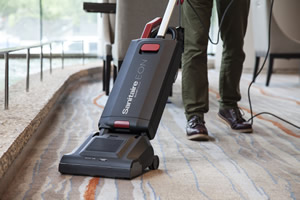What to Consider When Selecting Floor-Care Machines
 Cleaning equipment selection is becoming ever more important for facilities managers and custodial directors as North America's schools grapple with flattening operating budgets.
Cleaning equipment selection is becoming ever more important for facilities managers and custodial directors as North America's schools grapple with flattening operating budgets.
“Custodial directors often wrestle with the question of when to replace or repair floor-care equipment,” said Brad Hoare, product manager, Sanitaire. “New equipment is a significant expenditure, especially when spending-per-student is tight. But remember, the machine’s price is only one factor.”
Below are other factors to consider:
- Machine life: Determine the machinery's cost of ownership. Product warranties offer some guidance. Examine the warranty period and determine the number of hours the machine will be used during that span. Also look for machines that are easy to maintain. Every minute it takes to change vacuum bags, brushrolls and filters is a minute the machine is out of service. Look for equipment with easy access compartments to replace disposables or remove clogs. Also consider products that assemble quickly and without the use of tools.
 Worker comfort: The weight and maneuverability of equipment plays a key role in minimizing stress and maximizing the productivity of cleaning crews. Ergonomic design that shifts weight from the handle to the base of the machine helps crews operate productively and with less musculoskeletal stress.
Worker comfort: The weight and maneuverability of equipment plays a key role in minimizing stress and maximizing the productivity of cleaning crews. Ergonomic design that shifts weight from the handle to the base of the machine helps crews operate productively and with less musculoskeletal stress.- CRI Certification: Look for equipment that has earned the Carpet and Rug Institute (CRI) Seal of Approval. This certification rates machines for soil removal capabilities, dust containment and their impact on carpet appearance and wear. The Sanitaire EON™ QuietClean® holds the CRI's gold rating and it emits only 69 decibels of operating sound, so it meets green cleaning standards of the U.S. Green Building Council's LEED program.
- Machine capacity: Consider machines that are built to cover more area more quickly, such as wide-area vacuums that can clean up to a 28-inch path, or backpack vacuums that can speed area cleaning or above-the-floor cleaning.
- Air Quality: Did you know 40 percent of students suffer from respiratory allergies or asthma? This causes them to miss tens of thousands of days of school each year. If your educational facility is located in areas prone to high-levels of air allergens during key seasons, consider a machine that is certified by the Allergy and Asthma Foundation of America. Sanitaire’s EON™ ALLERGEN helps reduce exposure to allergens and irritants, provides increased environmental control and withstands routine cleaning and care.
Sponsored by: Sanitaire